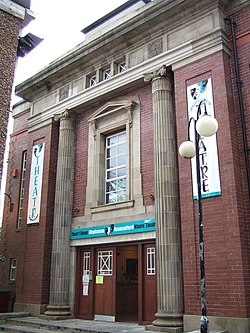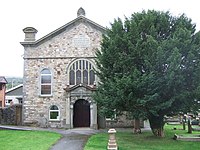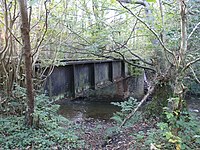Ammanford: Difference between revisions
Created page with '{{Infobox town |name= Ammanford |welsh=Rhydaman |county = Carmarthenshire |picture= Miners' Theatre, Rhydaman-Ammanford - geograph.org.uk - 272802.jpg |picture caption= Miners' …' |
No edit summary |
||
| Line 16: | Line 16: | ||
|constituency=Carmarthen East & Dinefwr | |constituency=Carmarthen East & Dinefwr | ||
}} | }} | ||
'''Ammanford''' is the third largest town in [[Carmarthenshire]], with a population 12,615 | '''Ammanford''' is the third largest town in [[Carmarthenshire]], with a population 12,615 recorded at the 2001 census. Ammanford town is the main shopping centre for many villages in the surrounding area. | ||
According to the 2001 census, 75.88% of the population are competent in the Welsh language, compared to roughly 55% in Carmarthenshire as a whole and 21.8% in Wales as a whole. | According to the 2001 census, 75.88% of the population are competent in the Welsh language, compared to roughly 55% in Carmarthenshire as a whole and 21.8% in Wales as a whole. | ||
Revision as of 18:34, 9 February 2018
| Ammanford Welsh: Rhydaman | |
| Carmarthenshire | |
|---|---|
 Miners' Theatre, Ammanford | |
| Location | |
| Grid reference: | SN625125 |
| Location: | 51°48’-0"N, 3°59’35"W |
| Data | |
| Population: | 5,299 (2001) |
| Post town: | Ammanford |
| Postcode: | SA18 |
| Dialling code: | 01269 |
| Local Government | |
| Council: | Carmarthenshire |
| Parliamentary constituency: |
Carmarthen East & Dinefwr |
Ammanford is the third largest town in Carmarthenshire, with a population 12,615 recorded at the 2001 census. Ammanford town is the main shopping centre for many villages in the surrounding area.
According to the 2001 census, 75.88% of the population are competent in the Welsh language, compared to roughly 55% in Carmarthenshire as a whole and 21.8% in Wales as a whole.
Naming

The village was originally known as "Cross Inn", having developed around an inn of that name at a crossroads. The village's rapid growth in the late nineteenth century brought a need for a distinctive name, as another village in Carmarthenshire already ore the name Cross Inn. Prominent citizens convened a public meeting with a view to changing the name, and there was overwhelming support for the proposal, especially amongst the strong representation of church and chapel members who perhaps resented the hamlet bearing the name of a public house. Another consideration appears to be that the largest chapel in the village was then known as Cross Inn Chapel: a conflict of ideals, to say the least. There is still an engraved stone in the grounds of the chapel, now called Gellimanwydd or the Christian Temple, bearing its original name.
On the 1 October 1880, this article appeared in the local newspaper:
It has been proposed to call CROSS INN, which is in the parish of Llandybïe, in the County of Carmarthen, from this time forth, after the Right Hon. Baron, who owns the place, Dynevor. By adopting a new name, it is hoped to get rid of all previous annoyances, and also, that the other Cross Inn may benefit by the change.
From later press reports, it seems that there was by no means unanimity in the selection of the new name. Several public meetings followed and eventually it was decided to refer the choice of a new name to a group of prominent local dignitaries. On 20 November, the nominated committee met at the Ivorites Hall (on Hall Street, which took its name from this building). After a long discussion it was proposed by Mr. A. A. Morris of Wernolau, and seconded by Mr. W. Jones of the Cross Inn Hotel, that from this time forth, the village should be known as Ammanford. The proposal was accepted unanimously, there being no other name before the meeting. After the vote was taken, the chairman of the meeting, Watkin Hezekiah Williams (Watcyn Wyn), a local schoolmaster, could not resist announcing that 'Cross Inn' had finally been 'crossed out'.
History
Ammanford took its current name on 20 November 1880. The community that existed then and now known as Ammanford dates back to around the early 19th century. At that time the main highways went through the area, not to it. The north-south road from Llandeilo and Llandybïe went to Betws, and the east-west road from the Amman Valley went to Penybanc and Tycroes, and further afield, both converging at a crossroads (now Ammanford Square). This in turn led to the development of coaching inns or staging inns and taverns catering for the needs of the traveller. The area eventually became identified by the name of one of these hostelries, the Cross Inn.
The community of Cross Inn centred on the activity of the cross road, along with a small group of low-grade cottages sited in the vicinity of Carregaman Isaf which became known as Pentrefacas. Betws was a larger hamlet with the parish church, St David's, as its focal point. All the area to the west of the River Amman fell within the parish of Llandybïe.
The Industrial Revolution created a demand for coal, an essential source of power to operate the boilers of steam engines. Coal attracted investment which led to various companies, one of which was the Llanelly Railway and Dock Company, building an elaborate transport system of railways. The first railway was opened in 1840, linking Llanelli with Ammanford, reaching Brynamman by 1842 and later extending northwards to Llandeilo and beyond.

Coal could not be mined without manpower, and so an influx of workers began. People needed houses, services, entertainment, and schools. Within a relatively short period of time, what was once a quiet and tranquil agricultural community changed to a bustling town, hungry to absorb the land of old established farmsteads. The population increased explosively, with many of the migrants and their families coming from English-speaking areas of Wales as well as from elsewhere in the British Isles.
Twentieth century
Ammanford was an important location as the 1904–1905 Welsh Revival unfolded.
The Ammanford Anthracite Strike was a riot at Ammanford in 1925 during a strike by anthracite miners who took control of the town by force and violence for 10 days. 200 Glamorgan police were ambushed by strikers at Pontamman Bridge during the so-called 'Battle of Ammanford'.[1]
Ammanford hosted the National Eisteddfod in 1922 and 1970.